Results 41 to 49 of 49
-
01-24-2019, 11:59 AM #41

It was intentional, Iíve seen too many framebacks fitted up that way.
I donít recall ever seeing a non-frameback fitted like that, most razors of this age arenít hollowground thinly enough to have an issue, most were near wedge, 1/4 hollow, etc and the blades sat higher in the scales as a result.
I suspect that your razor has been swapped into a set of scales that were original to a frameback/rattler, so that, not shrinkage, would explain why theyíre short for the blade. Scale swaps in the old days were fairly common. Horn doesnít shrink much, but it can warp and cause issues.
Cheers, Steve
-
The Following User Says Thank You to Steve56 For This Useful Post:
Montgomery (01-24-2019)
-
01-24-2019, 02:03 PM #42Senior Member

- Join Date
- Sep 2009
- Location
- Plymouth, UK
- Posts
- 313
Thanked: 19
Luckily, these scales are dead straight. However, if horn scales don't shrink, that raises a conundrum... if the scales are original, and they haven't shrunk, why was the blade resting on the asymmetrical wedge? Was it all intentional? Did I even need to file the wedge down?
-
01-24-2019, 02:58 PM #43

If the cutting edge at the toe doesn’t hit the wedge you don’t need to do anything.
Cheers, Steve
-
01-24-2019, 02:58 PM #44

Steve, that is indeed interesting about the blade resting upon the wedge. It makes sense to me, though I'd prefer to make the scales a large enough size or use the third pin.
Most of the razors that I've seen with short scales, blade resting upon the wedge, have not been framebacks.
I'll take a picture when I get off work, the example I have is a Remeau Sens quarter hollow with short horn scales.
Nice Rattler! I particularly like those French blades.ďYou must unlearn what you have learned.Ē
Ė Yoda
-
01-24-2019, 03:28 PM #45

Thanks MikeT, it shaves really, really well.
Scales as wide as that blade would be esthetically unpleasing (ugly) and probably cost twice as much because they have twice the material in them. Most French razors of this vintage always reminded me of the American razors, they were utilitarian things, just tools for ordinary people and so they very much respected a Franc and doubling the cost of the scales wouldnít fly I think.
The third pin on my Gauthier came about as a result of the rescale, which as far as shape goes copies the original scales. Iíve never seen a third pin used this way on framebacks or rattlers, but Iím sure thereís one out there somewhere! Alfredo (Doc226) made the scales and we talked quite a bit about that curved wedge and the third pin. I was OK with the curved wedge, but Alfredo thought that the third pin was better, and the third pin has a sleeve around it between the scales, so the top of the sleeve sits higher than the pin and stops the blade.
Cheers, Steve
-
01-24-2019, 05:35 PM #46

Hereís another example that I mentioned, a C. H. Guerre rattler. Itís ground the same way, and in one if the images you can see (pretty much) the nose hitting the wedge when closed. You can also see that the blade is wider than the scales, which are also horn. This razor probably dates to the 1860s or so, I donít know when Guerre ceased operations.
Cheers, Steve
-
01-24-2019, 07:36 PM #47

That is a tough one. Can't control where the blade sits using the usual method of wedge thickness.
Some protrusions from the top of scales have been done to stop the blade.
I haven't seen it done on these rattlers with the third pin but that seems a good way.
I'd have to disagree to some extent on the scale size and esthetics. Whereas I don't prefer Cadillacs, but if it is a large blade, it requires larger scales.
I like the style of a blade resting down into scales, but also sitting higher I like too. Just depends.
Here are 3. Two Remeau Sens, and one marked Paris.
The larger Remeau is a hair under 8/8. Really looking forward to rescaling it!
The smaller Remeau is way too big for the scales, with tip resting on the wedge. The scales are horn, but seem to have a thick finish on them if some kind, strange. Not original scales.
I also see what you mean by "utilitarian". Many French blades were not so fancy. Perhaps this French industry was aimed at a more common demographic.
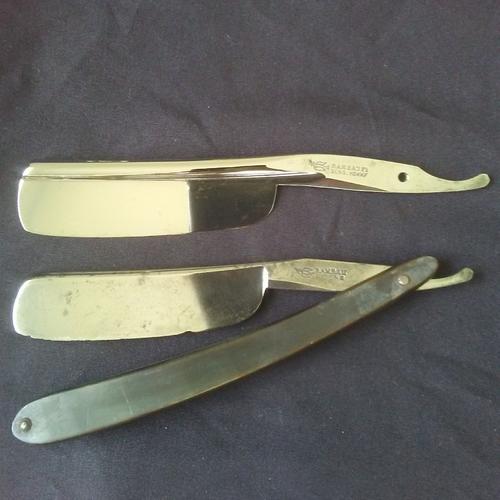
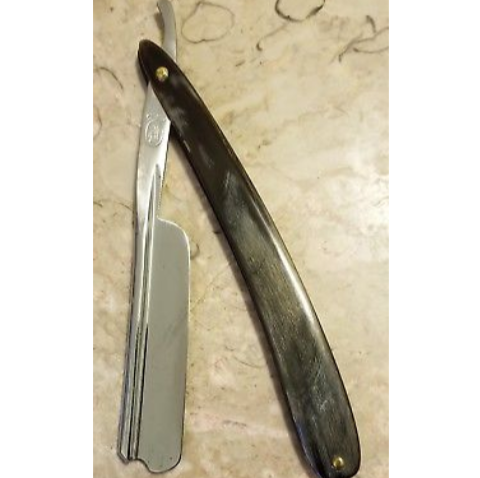 ďYou must unlearn what you have learned.Ē
ďYou must unlearn what you have learned.Ē
Ė Yoda
-
01-24-2019, 09:28 PM #48

I like those Remeau (Remeaux? Lol) ! That unscaled large one is gorgeous !
I’ve had quite a few that the black horn looked like it was finished by rubbing it on the sidewalk. When they were polished up, they were all very pretty indeed. They just didn’t put much effort into the cosmetics on many of the early razors.
Cheers, Steve
-
01-26-2019, 07:16 PM #49Senior Member

- Join Date
- Sep 2009
- Location
- Plymouth, UK
- Posts
- 313
Thanked: 19
After identifying these scales as horn, had a look at a few other razors where I was unsure about the scale material, and it turned out another was also horn. It is a German-made French-branded razor. Interesting thing is, although the blade does not rest against the wedge, it also has an asymmetric wedge. This razor came in the same lot as the one that was the original subject of this thread, which was a box of stuff from a long-gone barber shop. There were only two French razors in the lot, and both have an asymmetric wedge.
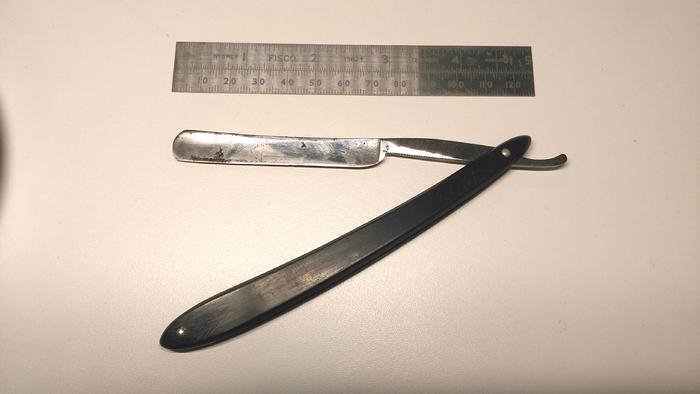
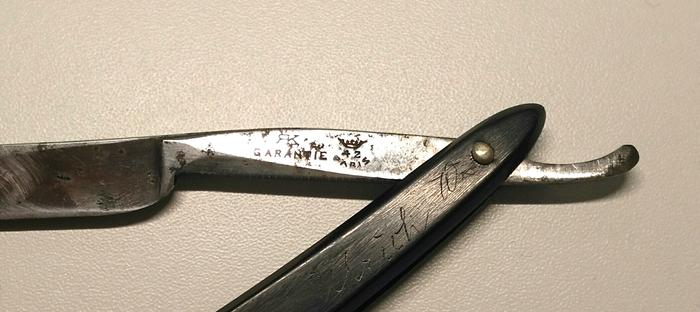
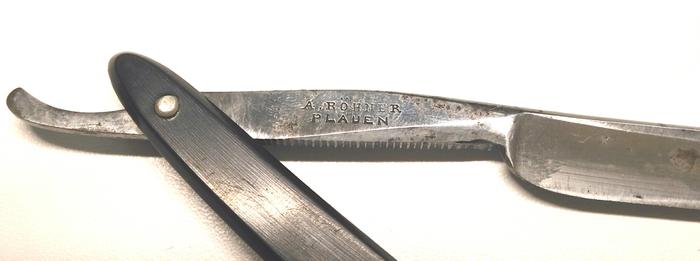
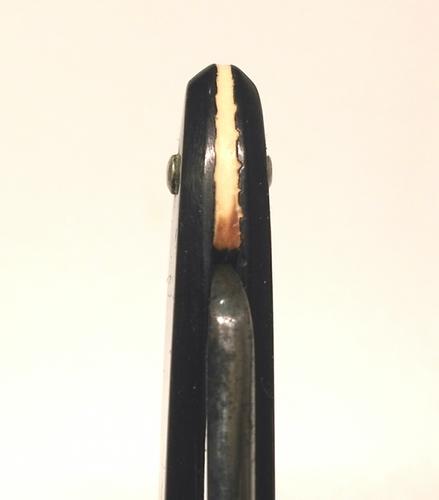
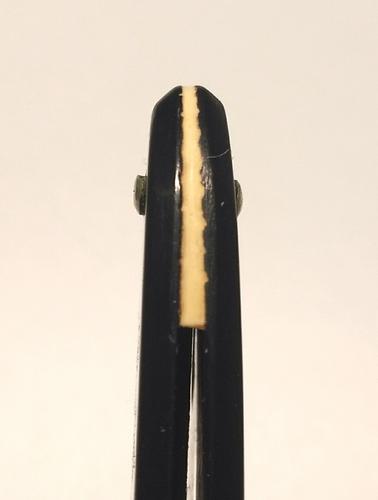
So perhaps it isn't that uncommon even on razors which aren't framebacks.


 97Likes
97Likes LinkBack URL
LinkBack URL About LinkBacks
About LinkBacks






 Reply With Quote
Reply With Quote
